This is a Pentax ES II Single Lens Reflex camera made in Japan by Asahi Pentax. It is one of the very few M42 screw mount cameras that is capable of auto exposure, and was the very last screw mount camera made by Asahi Pentax before they switched to K-Mount bayonet lenses. The ES II added a few new features to the earlier ES model such as a new battery compartment, slower shutter speeds, and a viewfinder blackout curtain. Both the ES and ES II were based off the compact and lightweight body of the Pentax Spotmatic which were extremely successful throughout the 1960s and early 70s. Although the ES II could use it’s auto exposure on almost any M42 screw mount lens, it required the Super Multi Coated Takumars for full open aperture metering. When using non-SMC lenses, the photographer must use stop-down metering.
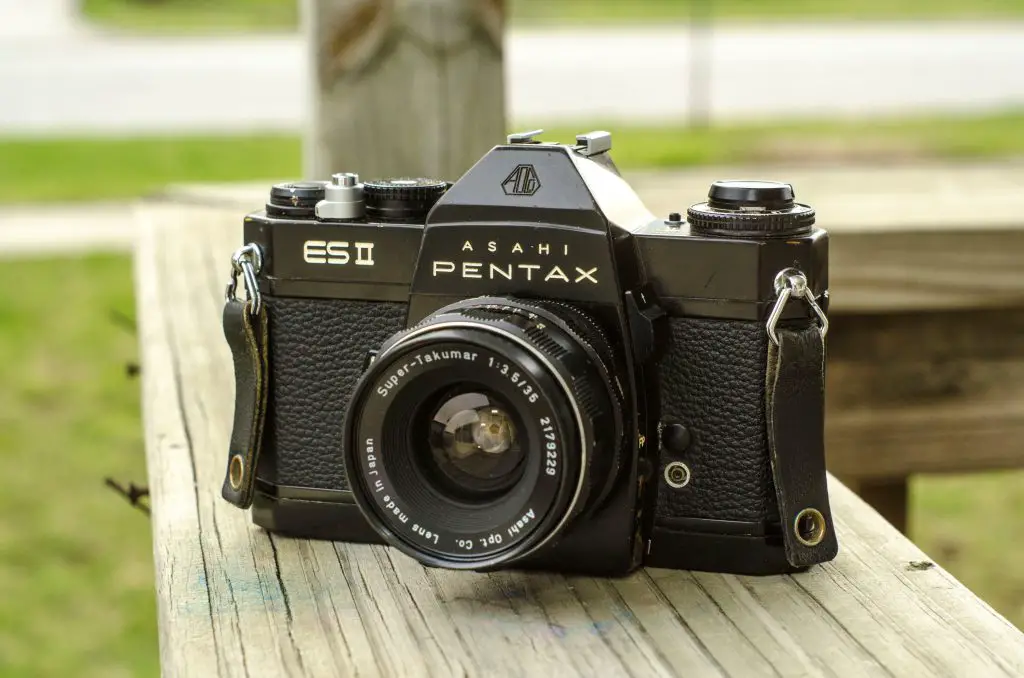 Film Type: 135 (35mm)
Film Type: 135 (35mm)
Lens Mount: M42 Screw Mount
Lenses: 50mm f/1.4 Super Multi Coated Takumar 6-elements
Focus: Fixed SLR Pentaprism
Shutter: Focal Plane Cloth
Speeds (Electronic): 8 – 1/1000 seconds
Speeds (Mechanical): B, 1/60 – 1/1000 seconds
Exposure Meter: CdS TTL Meter with Aperture Priority Auto Exposure
Battery: 4 x S76 Silver-Oxide 1.5v
Flash Mount: Hot Shoe, plus PC M and X Flash Sync
Weight: 898 grams (w/ lens), 685 grams (body only)
Manual: http://www.butkus.org/chinon/pentax/pentax_esii/pentax_esii.htm
How these ratings work |
The Asahi Pentax ES II is an oddity in the SLR world. It was one of the very last screw mount M42 cameras, yet it has auto exposure which was still a new feature in the early 1970s. This camera bridged the gap between the next generation of modern SLRs, while allowing photographers to still use a huge array of M42 lenses. Even though it was the M42 screw mount’s last hurrah, Asahi did not skimp on the quality. This is an extremely well built camera with excellent ergonomics, and it is a joy to hold and shoot with. The Super Takumar SMC 50/1.4 lens is as sharp as they come, and the auto exposure system handled a variety of lighting conditions well. Looking through my results, I have a hard time remembering which shots I took with the meter on or off. This is an excellent camera, and if you have a collection of M42 lenses and want to try out auto exposure with them, there isn’t anything better than the ES II. This is one of my favorite SLRs in my entire collection and one I will definitely come back to again. | ||||||
| Images | Handling | Features | Viewfinder | Feel & Beauty | History | Age | |
| 2 | 2 | 1 | 1 | 2 | 1 | 0% | |
| Bonus | +1 for it’s fool proof implementation of screw mount auto focus and consistently amazing shots | ||||||
| Final Score | 10.0 | ||||||
History
The company name Pentax still exists today as a brand of reputable digital SLRs owned by the Ricoh company. Pentax was sold by it’s parent company Hoya to Ricoh in 2011, but prior to that was known as the Asahi Optical Company (Asahi Kōgaku Kōgyō K.K. in Japanese), based out of Tokyo. This version of Pentax traces it’s roots back to 1919 when it was originally formed as Asahi Kōgaku Kōgyō G.K., an optics company who made glasses and lenses for other companies.
Asahi would make a variety of optical products both before and after World War II, but perhaps their greatest success was the Pentax Single Lens Reflex. The Pentax was originally released as the Asahiflex in 1952 and was the very first Japanese made SLR camera. It used the M42 screw mount popularized by the German company Praktica, making it fully compatible with existing German lenses. The Asahiflex was very well built and sold well both in Japan and in export markets. Despite it’s success, the Asahiflex lacked a pentaprism viewfinder which was the key feature that would differentiate a modern SLR from earlier models.
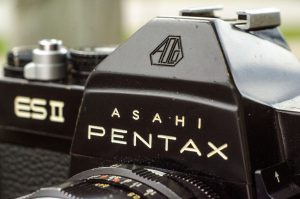
In 1957, Asahi would release the Asahi Pentax, a SLR with a pentaprism viewfinder. It would retain the Asahiflex’s M42 screw mount meaning that it supported any Japanese made lens for the Asahiflex along with the many German made M42 lenses of the day. The Asahi Pentax was an immediate success. It was exported all over the world under a variety of names, and over the course of the next decade, many different variants would be released.
In 1964, a new Pentax called the Spotmatic would be released that shared many of the same design elements of the original Pentax, but it’s significant new feature was a match needle light meter. Unlike many early attempts by Japanese companies at incorporating light meters into SLRs, the light meter of the Pentax Spotmatic was inside of the pentaprism and was not externally visible. Perhaps even more significant, Pentax was able to squeeze all of the electronics into the Spotmatic without any significant change in size of the camera. Most other metered SLRs of the mid 60s had very tall top plates and were considerably heavier. Because of it’s compact size, wide variety of lenses, and accurate electronic meter, the Asahi Pentax Spotmatic was one of the best selling cameras of the mid to late 60s.
By the time the 1970s started, demand for more advanced electronics and auto exposure was increasing. In order for auto exposure to work, there has to be some level of communication between the lens and the camera. The camera has to know which aperture is selected on the lens before it can calculate an appropriate shutter speed. Many companies would use some form of mechanical linkage between the lens and the camera that would communicate which aperture was selected on the lens. The problem with any type of mechanical linkage was that the position of the linkages must be exactly the same each and every time. The camera has to know exactly where the position of the linkage is to get an accurate idea of which aperture is selected.
Since all Pentax cameras up until this point had used screw mount lenses, there was no easy way to mechanically link the lens to the camera as there would be slight variances in rotation between different lenses. You’ll notice on many screw mount lenses that sometimes the depth of field chart is not always at top dead center when mounting the lens to the camera. This isn’t a problem on pre-AE cameras, but it became a huge problem for auto exposure.
As a result, by the early 1970s most companies had dropped support for the M42 screw mount. The remaining few screw mount cameras would be entry level models that still relied on full manual control or match needle exposure meters like the earlier Spotmatic. Asahi would begin working on a bayonet lens mount which they would later release as the K-mount in 1975, but until that new mount was ready, they devised an ingenious way to adapt screw mount lenses and still support Auto Exposure.
![00X86Q-271955584[1]](https://mikeeckman.com/wp-content/uploads/2016/04/00X86Q-2719555841-220x300.jpg) When it was released in 1971, the Pentax ES was advertised as the “world’s first SLR camera with a fully automatic electronic shutter”. While it retained the same basic body shape as the Spotmatic, it was a bit taller and heavier than it’s predecessor. It also featured an all new dual electronic/mechanical shutter that would fire electronically in Auto mode, but would also have a limited number of manual speeds that would work without a battery. The electronic shutter was step less from 1 second all the way to 1/1000 second.
When it was released in 1971, the Pentax ES was advertised as the “world’s first SLR camera with a fully automatic electronic shutter”. While it retained the same basic body shape as the Spotmatic, it was a bit taller and heavier than it’s predecessor. It also featured an all new dual electronic/mechanical shutter that would fire electronically in Auto mode, but would also have a limited number of manual speeds that would work without a battery. The electronic shutter was step less from 1 second all the way to 1/1000 second.
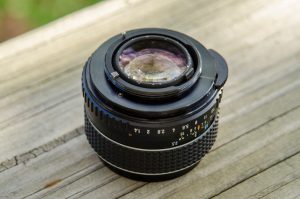
Asahi accomplished auto exposure on a screw mount camera by “stopping down” the lens to the chosen aperture and take a light meter reading an instant before actually firing the shutter. All of this would happen so fast, that the photographer wouldn’t notice a delay in between pressing the shutter release and the camera actually taking the exposure. Although this was a workable solution, it had one pretty big drawback. In order for this new system to work, it required a special type of M42 lens called the Super Takumar with a diaphragm coupling lever in order to achieve full wide open auto exposure. The auto exposure system would still work with non-Super Takumar lenses without the diaphragm coupling lever, but it required stop-down metering, which means the lens has to already be stopped down prior to firing the shutter. This might not seem like a big difference, but the problem is that when the lens is already stopped down prior to taking the picture, the viewfinder becomes darker and darker each time a smaller aperture is selected.
If you have an SMC lens with the diaphragm coupling lever, you can achieve full auto exposure at any aperture while keeping the lens wide open during composition. When firing the shutter, the lens would stop down, take a meter reading, capture the image, and then reset all within a fraction of a second. Without an SMC lens, you must stop down the lens first, which darkens the viewfinder, and then the camera handles the rest of the auto exposure process. While this wasn’t a perfect solution, it did offer a “step-up” option for people with existing M42 lenses wishing to have a modern auto exposure camera. The alternative would be to start from scratch with a whole new lens mount.

The Pentax ES II was released in 1974 and improved upon the original design by expanding the electronic shutter to allow speeds as slow as 8 seconds, it added a self timer, a new shutter blind system for accurate exposure at very slow shutter speeds, and a new battery compartment.
Today, most M42 screw mount Pentaxes are desirable by collectors due to their excellent build quality, great ergonomics, and wide selection of excellent lenses. The ES II still has the basic body shape of the earlier Spotmatic, but is a little taller and heavier. Although it came in both black and chrome, it seems to be more commonly found in black, which is a plus as most collectors seem to prefer black bodies over chrome ones.
My Thoughts
My Pentax Sv had grown to become one of my favorite classic SLRs. The best thing about that camera is it’s compact size and great ergonomics. As my collection grew, I started to acquire a pretty nice selection of M42 screw mount lenses including several excellent Takumars. Although I have no problem shooting with an all manual camera like the Sv, I had started to become curious about auto-exposure. As I discuss earlier, there weren’t many options when it came to screw mount cameras with this feature. Only the ES, ES II, the Yashica Electro AX, and a small selection of cameras made by Chinon ever had auto-exposure and the M42 mount.

I picked up this ES II in parts condition for very cheap. It came with a 50mm f/1.4 SMC lens, but the focus ring was jammed, the meter didn’t work, and the camera was very dirty. I figured I could clean up the camera and possibly clean the battery compartment to see if I could get the electronics working and then try out a different lens.
Amazingly, I found a complete tutorial on Chris Sherlock’s Retina Rescue page with instructions on dismantling this exact lens. Armed with his instructions and a lens spanner, I was able to remove the front element and resolve the issue with the focus ring. It turns out all that had happened was a screw had backed off causing a metal plate to not move the helical. While in there, I cleaned as many of the elements as I could and put it back together and it seemed to work as good as new!
The body cleaned up nicely, so I replaced all of the light seals and got some batteries. One of the changes to the ES II from the original ES model is that the battery changed from a single 6v PX28 battery to four 1.5v S76 batteries. I think this is one change in which the ES II is inferior to the original model as I prefer the single 6v battery over 4 silver oxide ones. I didn’t notice any obvious corrosion in the battery compartment, but upon putting in new batteries I still couldn’t get the meter to respond. I took a pencil eraser and tried to rub as much of the metal “fingers” as I could and upon putting the batteries back in, the meter started responding!
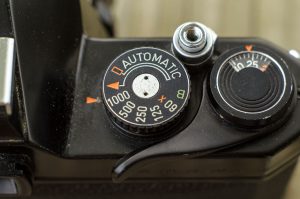
Even if I had not been able to restore the automatic shutter, the ES II has 5 mechanical shutter speeds from 1/1000 down to 1/60 plus Bulb mode. This is in contrast to many electronic shutter cameras that have no mechanical speeds at all. Even the electronic Nikons of the era only had one speed, making this a capable outdoor camera.
The shutter seemed to fire correctly at all speeds. I even tested the speeds longer than a second and they all seemed to work correctly! I was elated that not only was I able to fix the issue with the lens, but now the electronics were working as well!
Although the ES II is marginally taller and heavier than the earlier Spotmatics or my Pentax Sv, this is still a very comfortable camera to hold. The ergonomics are great, and thankfully Asahi had resisted the urge of plastic tipped wind levers and kept the all metal design. I really like holding this camera and plan on using it again and again, especially if I can permanently fix the meter. If I had only one complaint about the design, it would be that the viewfinder lacks a split image rangefinder in the focus screen. Instead you just have a standard microprism circle, which limits my ability to focus in certain situations. By 1974 when this camera had been released, Nikon and other companies had already started to make the split image rangefinder a common feature, so it’s a bit disappointing that Asahi didn’t do the same. Other than this one little nitpick, this camera is nearly perfect.
As is typical with most Japanese made cameras from the 1970s, the light seals were crumbling, so I replaced them in the same manner I do every camera, with some black yarn and black adhesive felt. I loaded in some film and went shooting.
My Results
Whenever I acquire a new “old” camera, I play with it quite a few times to familiarize myself with the controls of the camera, but also to assure that it is working properly. Earlier I mentioned I had to repair the lens and clean the battery compartment to get the camera to work properly, so when I was satisfied this camera checked out, I loaded in film and went shooting.

Sadly, there appeared to be some sort of electrical gremlin causing intermittent power to the meter and shutter. At times while shooting with the camera, the meter and shutter worked fine, but then it would suddenly lose power. I found that by putting quite a bit of pressure onto the battery door, I could sometimes get it to work properly, but then it would stop working altogether. I took the batteries out to see if anything looked off, but nothing appeared to be any different. I had made it maybe a third of the way through the roll before this started happening and I got sick of trying to put pressure on the bottom of the camera, so I just decided to shoot the rest of the roll using one of the mechanical speeds.
This basically negated any benefit from the auto exposure feature of the camera and turned it back into an all black, but also larger and heavier Pentax Sv. Still, it’s a Pentax, and it had an awesome lens mounted so I didn’t mind too much. My Pentax Sv is one of my favorite cameras in my collection and one that is in much better condition than many I see online, so it’s not a camera I take out places where it might get roughed around a bit. My plan is to come back to this ES II someday and see if I can figure out where the short is, but if I can’t, it will be my “outdoor” beater Pentax. With 200 or even 400 speed film, I can use Sunny 16 all day long with the 1/60 – 1/1000 shutter speeds without blinking an eye. The picture to the left shows my 2 year old son holding the Pentax. While he’s generally pretty gentle with “daddy’s kamas” I probably would not have let him hold my Sv!
It should probably come as no surprise that a Pentax camera with a Super Takumar lens turned out some great shots. About half of these shots were done with the built in meter, and the other half are Sunny 16 after the meter started acting up. I am starting to think that Pentax screw mount cameras have some mystical powers as it really doesn’t matter what you throw at it, your shots will still turn out awesome.
I typed several comments about each of the shots above, so go into the gallery to read them. I wont repeat much here, other than to say, that several of these shots were some of my favorite shots of the entire batch of 15 rolls I got back from Dwayne’s Photo. I wish I remembered which roll of film I used, because I love the look that this roll gave me. I don’t shoot many 36 exposure rolls, but I am glad I did for this camera as I got so many great shots.
Seeing how well the meter handled a variety of lighting conditions, I plan on revisiting this camera again and trying to resolve the electrical issue once and for all. While it would still make for an excellent manual only camera, now that I’ve seen what it can do, I want to make it work reliably.
Additional Resources
http://camerapedia.wikia.com/wiki/Pentax_ES_II
http://camera-wiki.org/wiki/Pentax_ES_II
https://zorkiphoto.co.uk/2013/09/29/pentax-esii-camera-review/
http://www.pentaxforums.com/camerareviews/pentax-es-ii.html
https://chemicalcameras.wordpress.com/asahi-pentax-es-ii/


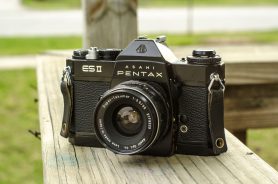











Excellent review!
Thanks for the link! Such a nice camera too!
Nice review. Spotmatics can have their share of age-related issues, and it seems to be somewhat hard to find these in really good working condition.
Just to note that the Fujica ST901 and AZ-1, the Praktica EE2 and EE3, and Zenit-18 were also automatic screw-mount cameras. Zenit continued to make screw-mount cameras as late as 2005.
I knew about the ST901 (which continues to be on my wish list), but didn’t realize the AZ-1 was M42! Thanks for the additional info!
Chinon and Revueflex (Germany) made M42 Autos as well + a terrific multi-purpose winder + a metal focal plane shutter. Their lenses are top of the line! Not many available as not many were made. Find one? Buy it. Heavy and bulky like the ES2 but well worth effort. Check ’em out. Have fun…..!
Excellent Spotmatics are out there but they ain’t cheap. Best countries for these are JAPAN, UK & GERMANY. UK & Germany are excellent eBay sites as well.
I have had a couple Spots CLA’d for a reasonable price – and they look and perform very nice, thank you.
Just to remind you that Asahiflex used M39 thread lenses, only Asahi Pentax started with M42 lenses.
Sorry sorry 🙂 memory lapse.. it was M37 lenses, so it was rather strange size
Hello Mike, I’ve recently acquired a Spotmatic ES II, to take it apart and see if I could make it work.
I’ve had quite a bit of fun with it, one thing I’ve noticed is that a switch closes every time a picture is taken. You find it on the base of the camera, it is a leaf spring switch.
In my case, the plastic that made the switch has deteriorated, so the leafs didn’t make a good connection when the button was pressed.
I’ve bended the leaf at the bottom, a bit with a pair of tweezers, checking that it did make contact each time I try to take a picture.
This may be the cause of the issue you have.
Thank you for the inspiration, I wish you the best.
Hello Mike,
I love Pentaxes and the ESII was my first ‘serious’ camera. Thank you for your great review. Did you manage the intermittent battery contact? One small remark on your text. You state: “When firing the shutter, the lens would stop down, take a meter reading,…”. Isn’t it the other way around? First take the meter reading and then stop down? It is an open meter reading camera after all.
Once again, thank you for your great review!
Regards, Wim van Heugten
Thanks for the compliment Wim! The way the metering system on the ES II and other auto exposure M42 cameras like the Chinon Memotron is that since screw mount lenses don’t have any other way of reporting back to the body which aperture you have selected, it must first stop the lens down before it can take a reading. On Nikon’s Ai lenses or comparable bayonet mounts, there is a tab on the lens mount side of the lens that the body can use to “feel” what f/stop the lens is set at. The meter can then take an open meter reading and compensate for the number of stops needed to get an accurate exposure. The M42 lens mount does not have these tabs, so the workaround was that it must wait for the lens to first stop down before taking the reading.
Sorry to disagree with you on this. The square protrusion on the back of the lens flange is to register the exact angle of the lens with respect to the camera. Needed because of the screw mount thread does not guarantee the positon of the lens as with a bayonet mount. The other lever is signaling to the light meter the number of F-stops the lens aperture ring has been turned. Now the light meter can do a light measurement at full opening and correct the shutter time according to the number of F-stops the lens has been stopped down.You might see how it works when comparing two lenses with differing full apertures (let’s say a F/1.4 standard lens and a F/4 tele. The position of the second lever is equivalent to the number of stops the aperture ring is turned. And all this is only true for the last generation SMC lenses of course.
Mike, time for an update. Did you ever resolve the erratic light meter issue? Is an ESII worth seeking out now in 2020? Thanks!
I did not ever resolve the issue. I concluded it was electrical and would have likely required a tear down of the camera. To be honest, even though I liked the ESII, I have never come back to it since writing this review. I actually prefer the functionally similar Chinon Memotron CEII and the Fujica ST-901 to the ESII, but they’re all pretty comparable cameras.
The biggest difference between the ESII adn the Cinon Memotron and others is that the ESII has actual open lens metering, making a big difference under low light conditions.
@Kodachromeguy: Did you read the post of Pietro from January 5, 2019?
Thought you should know there are two errors in your article:
1) In the article, you say:
“In order for this new system to work, it required a special type of M42 lens called the Super Takumar with a diaphragm coupling lever in order to achieve full wide open auto exposure.
In fact, Pentax introduced the SMC or Super Multi Coated Takumars to work with the auto-exposure of the ES, ES2 (and the open-aperture-metering of the SPF), not the Super-Takumars.
2) In the article, you say:
“The Super Takumar SMC 50/1.4 lens is as sharp as they come …”
It is, but the “Super-Takumar” and “SMC Takumar” were two different series of M42 lenses.
To avoid confusion that could result in damage to the camera, you should omit referring to the lens as a Super-Takumar.
According to the warning on page 19 of the instruction manual, the Super-Takumar 50mm f/1 .4 is one of two Super-Takumars that aren’t compatible with the ES or ESII:
The reason is that the rear elements extend too far, and it may interfere with the mirror.
thank you for an excellent article. I bought my Pentax es II at the navy exchange in sasebo Japan during our 1973 Westpac so it would have been late 73 or early 74. I used it a lot for many years including an outward bound alpine mountaineering trip in 86. I think I mostly just put it on auto and let it go. I always got great pictures with it. I haven’t used it for a long time and was thinking of selling it. I have the camera and standard lens but all of my big lenses seem to have gone away. after reading your article I believe I will keep it, find some film and someone who still does developing and start using it again. the digital cameras are good, but in two years they are obsolete because of the ‘advances’ in technology. my esII is 50 years old- and still ‘relevant’. again, thank you
I have a question I wonder if someone knows the answer to, regarding the lenses. The later SMC Takumar lenses are marked “SMC” Takumar. There are earlier ones marked “Super Multi Coated” Takumar (ie. SMC is spelled out). Do both types of lenses work on the ES II? Thanks!
Andrew: According to Camera-wiki, the answer is that lenses marked “Super Multi Coated Takumar” will work with automatic metering on the ESII, as will the later “SMC” lenses. Both should have the extra protrusions on the rear of the lens that convey the aperture information to the camera. Just make sure the lens matches the picture in Mike’s article above, and the picture in this link as well. http://camera-wiki.org/wiki/Takumar#Super_Multi_Coated_.28SMC.29_Lenses
I’m looking for someone to purchase my Pentax ESII camera, mounted in a cover carry case with strap. IncludesMC Takumar 1:2/55 Asahi lens with Tiffen 49M haze filter, plus Focal MC auto lens f= 28mm with Kamari polarizer 55mm, plus Takumar long range f=135mm Asahi lens in case, plus Honeywell Auot Strobonar 470 flash attachment. Any interest?
I was lucky enough to recently find an original Japanese Electro-Spotmatic in amazing shape on FB marketplace, working meter and all! Absolutely terrifying to look at inside, all of those hand assembled circuits.
I grabbed an era-appropriate 50mm 1.4 Super-Multi-Coated Takumar to go with it, I’m really looking forward to doing a test roll!